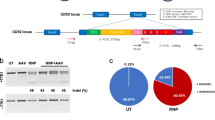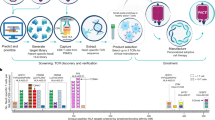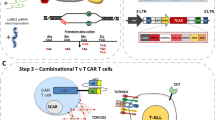Abstract
Genetic modification of human T cells to express transgene-encoded polypeptides, such as tumor targeting chimeric antigen receptors, is an emerging therapeutic modality showing promise in clinical trials. The development of simple and efficient techniques for purifying transgene+ T cells is needed to facilitate the derivation of cell products with uniform potency and purity. Unlike selection platforms that utilize physical methods (immunomagnetic or sorting) that are technically cumbersome and limited by the expense and availability of clinical-grade components, we focused on designing a selection system on the basis of the pharmaceutical drug methotrexate (MTX), a potent allosteric inhibitor of human dihydrofolate reductase (DHFR). Here, we describe the development of self inactivating (SIN) lentiviral vectors that direct the coordinated expression of a CD19-specific chimeric antigen receptor (CAR), the human EGFRt tracking/suicide construct, and a methotrexate-resistant human DHFR mutein (huDHFRFS; L22F, F31S). Our results demonstrate that huDHFRFS expression renders lentivirally transduced primary human CD45RO+CD62L+ central memory T cells resistant to lymphotoxic concentrations of MTX up to 0.1 μM. Our modular complementary DNA (cDNA) design insures that selected MTX-resistant T cells co-express functionally relevant levels of the CD19-specific CAR and EGFRt. This selection system on the basis of huDHFRFS and MTX has considerable potential utility in the manufacturing of clinical-grade T cell products.
This is a preview of subscription content, access via your institution
Access options
Subscribe to this journal
Receive 12 print issues and online access
$259.00 per year
only $21.58 per issue
Buy this article
- Purchase on Springer Link
- Instant access to full article PDF
Prices may be subject to local taxes which are calculated during checkout




Similar content being viewed by others
References
Volpato JP, Mayotte N, Fossati E, Guerrero V, Sauvageau G, Pelletier JN . Selectively weakened binding of methotrexate by human dihydrofolate reductase allows rapid ex vivo selection of mammalian cells. J Mol Recognit 24: 188–198.
Milsom MD, Fairbairn LJ . Protection and selection for gene therapy in the hematopoietic system. J Gene Med 2004; 6: 133–146.
Riddell SR, Elliott M, Lewinsohn DA, Gilbert MJ, Wilson L, Manley SA et al. T-cell mediated rejection of gene-modified HIV-specific cytotoxic T lymphocytes in HIV-infected patients. Nat Med 1996; 2: 216–223.
Berger C, Flowers ME, Warren EH, Riddell SR . Analysis of transgene-specific immune responses that limit the in vivo persistence of adoptively transferred HSV-TK-modified donor T cells after allogeneic hematopoietic cell transplantation. Blood 2006; 107: 2294–2302.
Muul LM, Candotti F . Immune responses to gene-modified T cells. Curr Gene Ther 2007; 7: 361–368.
Milsom MD, Williams DA . Live and let die: in vivo selection of gene-modified hematopoietic stem cells via MGMT-mediated chemoprotection. DNA Repair 2007; 6: 1210–1221.
Fossati E, Volpato JP, Poulin L, Guerrero V, Dugas DA, Pelletier JN . 2-tier bacterial and in vitro selection of active and methotrexate-resistant variants of human dihydrofolate reductase. J Biomol Screen 2008; 13: 504–514.
Gatlin J, Douglas J, Evans JT, Collins RH, Wendel GD, Garcia JV . In vitro selection of lentivirus vector-transduced human CD34+ cells. Hum Gene Ther 2000; 11: 1949–1957.
Allay JA, Persons DA, Galipeau J, Riberdy JM, Ashmun RA, Blakley RL et al. In vivo selection of retrovirally transduced hematopoietic stem cells. Nat Med 1998; 4: 1136–1143.
Ragg S, Xu-Welliver M, Bailey J, D'Souza M, Cooper R, Chandra S et al. Direct reversal of DNA damage by mutant methyltransferase protein protects mice against dose-intensified chemotherapy and leads to in vivo selection of hematopoietic stem cells. Cancer Res 2000; 60: 5187–5195.
Sorg UR, Kleff V, Fanaei S, Schumann A, Moellmann M, Opalka B et al. O6-methylguanine-DNA-methyltransferase (MGMT) gene therapy targeting haematopoietic stem cells: studies addressing safety issues. DNA Repair (Amst) 2007; 6: 1197–1209.
Larochelle A, Choi U, Shou Y, Naumann N, Loktionova NA, Clevenger JR et al. In vivo selection of hematopoietic progenitor cells and temozolomide dose intensification in rhesus macaques through lentiviral transduction with a drug resistance gene. J Clin Invest 2009; 119: 1952–1963.
Sawai N, Zhou S, Vanin EF, Houghton P, Brent TP, Sorrentino BP . Protection and in vivo selection of hematopoietic stem cells using temozolomide, O6-benzylguanine, and an alkyltransferase-expressing retroviral vector. Mol Ther 2001; 3: 78–87.
Ercikan-Abali EA, Mineishi S, Tong Y, Nakahara S, Waltham MC, Banerjee D et al. Active site-directed double mutants of dihydrofolate reductase. Cancer Res 1996; 56: 4142–4145.
Lewis WS, Cody V, Galitsky N, Luft JR, Pangborn W, Chunduru SK et al. Methotrexate-resistant variants of human dihydrofolate reductase with substitutions of leucine 22. Kinetics, crystallography, and potential as selectable markers. J Biol Chem 1995; 270: 5057–5064.
Flasshove M, Banerjee D, Bertino JR, Moore MA . Increased resistance to methotrexate in human hematopoietic cells after gene transfer of the Ser31 DHFR mutant. Leukemia 1995; 9 (Suppl 1): S34–S37.
Flasshove M, Banerjee D, Mineishi S, Li MX, Bertino JR, Moore MA . Ex vivo expansion and selection of human CD34+ peripheral blood progenitor cells after introduction of a mutated dihydrofolate reductase cDNA via retroviral gene transfer. Blood 1995; 85: 566–574.
Bertino JR . Cancer research: from folate antagonism to molecular targets. Best Pract Res Clin Haematol 2009; 22: 577–582.
Chunduru SK, Cody V, Luft JR, Pangborn W, Appleman JR, Blakley RL . Methotrexate-resistant variants of human dihydrofolate reductase. Effects of Phe31 substitutions. J Biol Chem 1994; 269: 9547–9555.
McIvor RS . Drug-resistant dihydrofolate reductases: generation, expression and therapeutic application. Bone Marrow Transplant 1996; 18 (Suppl 3): S50–S54.
Kowolik CM, Topp MS, Gonzalez S, Pfeiffer T, Olivares S, Gonzalez N et al. CD28 costimulation provided through a CD19-specific chimeric antigen receptor enhances in vivo persistence and antitumor efficacy of adoptively transferred T cells. Cancer Res 2006; 66: 10995–11004.
Sadelain M, Riviere I, Brentjens R . Targeting tumours with genetically enhanced T lymphocytes. Nat Rev Cancer 2003; 3: 35–45.
Wang X, Berger C, Wong CW, Forman SJ, Riddell SR, Jensen MC . Engraftment of human central memory-derived effector CD8+ T cells in immunodeficient mice. Blood 2011; 117: 1888–1898.
Berger C, Jensen MC, Lansdorp PM, Gough M, Elliott C, Riddell SR . Adoptive transfer of effector CD8 T cells derived from central memory cells establishes persistent T cell memory in primates. J Clin Invest 2008; 118: 294–305.
Crossland KD, Lee VK, Chen W, Riddell SR, Greenberg PD, Cheever MA . T cells from tumor-immune mice nonspecifically expanded in vitro with anti-CD3 plus IL-2 retain specific function in vitro and can eradicate disseminated leukemia in vivo. J Immunol 1991; 146: 4414–4420.
Treon SP, Chabner BA . Concepts in use of high-dose methotrexate therapy. Clin Chem 1996; 42: 1322–1329.
Zaharko DS, Fung WP, Yang KH . Relative biochemical aspects of low and high doses of methotrexate in mice. Cancer Res 1977; 37: 1602–1607.
Szymczak AL, Workman CJ, Wang Y, Vignali KM, Dilioglou S, Vanin EF et al. Correction of multi-gene deficiency in vivo using a single ‘self-cleaving’ 2A peptide-based retroviral vector. Nat Biotechnol 2004; 22: 589–594.
Donnelly ML, Luke G, Mehrotra A, Li X, Hughes LE, Gani D et al. Analysis of the aphthovirus 2A/2B polyprotein ‘cleavage’ mechanism indicates not a proteolytic reaction, but a novel translational effect: a putative ribosomal ‘skip’. J Gen Virol 2001; 82: 1013–1025.
Stastny MJ, Brown CE, Ruel C, Jensen MC . Medulloblastomas expressing IL13Ralpha2 are targets for IL13-zetakine+ cytolytic T cells. J Pediatr Hematol Oncol 2007; 29: 669–677.
Acknowledgements
We would like to thank Renate Starr, Araceli Hamlett, Winnie Wong and Sean Cho for their technical assistance, Xiuli Wang for the helpful discussions, and Xueli Liu for statistical analysis. This work was funded by NIH P50 CA107399, PO1 CA030206, the Lymphoma Research Foundation, the Tim Nesvig Lymphoma Research Foundation, the Neidorf Foundation, the Marcus Foundation, the Skirball Foundation, and the Timothy Lindenfelser Foundation.
Author information
Authors and Affiliations
Corresponding author
Ethics declarations
Competing interests
MCJ is an inventor of licensed intellectual property and a co-founder/equity of ZetaRx Biosciences, Inc. All other authors have no conflicts of interest to disclose.
Additional information
Supplementary Information accompanies the paper on Gene Therapy website
Rights and permissions
About this article
Cite this article
Jonnalagadda, M., Brown, C., Chang, W. et al. Efficient selection of genetically modified human T cells using methotrexate-resistant human dihydrofolate reductase. Gene Ther 20, 853–860 (2013). https://doi.org/10.1038/gt.2012.97
Received:
Revised:
Accepted:
Published:
Issue Date:
DOI: https://doi.org/10.1038/gt.2012.97
Keywords
This article is cited by
-
Homology-independent targeted insertion (HITI) enables guided CAR knock-in and efficient clinical scale CAR-T cell manufacturing
Molecular Cancer (2023)
-
Genetic engineering of T cells for immunotherapy
Nature Reviews Genetics (2021)
-
Paclitaxel and the dietary flavonoid fisetin: a synergistic combination that induces mitotic catastrophe and autophagic cell death in A549 non-small cell lung cancer cells
Cancer Cell International (2016)
-
Antithymidylate resistance enables transgene selection and cell survival for T cells in the presence of 5-fluorouracil and antifolates
Gene Therapy (2016)
-
Gene-engineered T cells for cancer therapy
Nature Reviews Cancer (2013)



